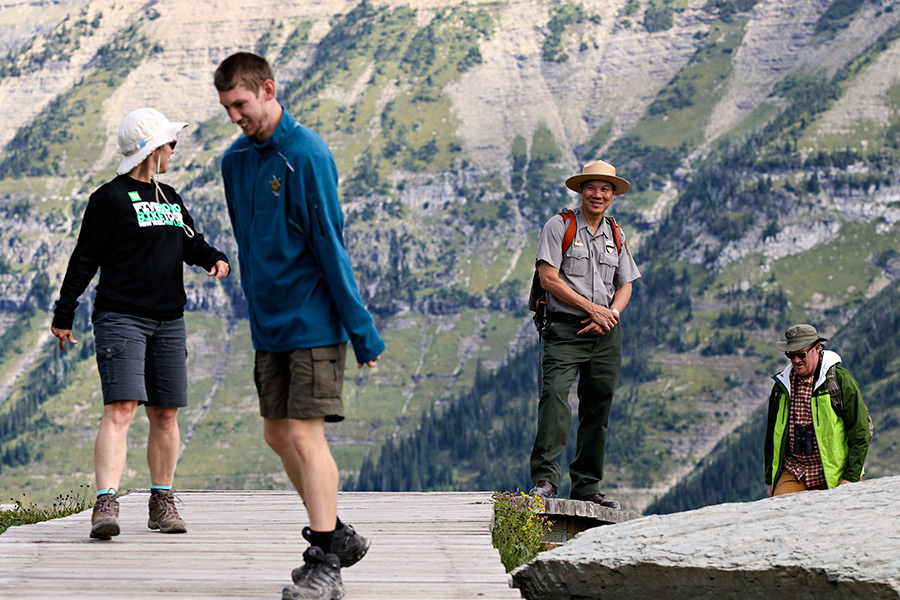By the time fireworks are set off to celebrate the end of 2016 and champagne glasses are hoisted to toast the arrival of 2017, nearly 3 million people will have visited Glacier National Park this calendar year, the most ever.
As the historic National Park Service centennial year draws to a close, officials at Northwest Montana’s largest attraction are taking a hard look at how Glacier Park handled the huge crowds and what to expect in the future, said Superintendent Jeff Mow.
“We’re still evaluating what we saw this year,” Mow said of the record visitation. “There is a lot to learn from 2016.”
Through November, 2.9 million people had visited Glacier Park, a 24 percent increase over the same period in 2015. That number is slightly higher than the figure first reported earlier this month because park officials realized that some West Entrance data from April and June were missing, spokesperson Lauren Alley said. Including that data increased the year-to-date visitation by approximately 100,000.
Mow said park officials expected a boost in visitation because of the centennial celebration, but they were surprised by how many more people came during the traditionally slower shoulder season. Nearly 31,000 people visited the park in November, a 58 percent increase in visitation over the same month last year. Mow said if that trend continues, the park might have to reconsider how it operates beyond its traditional summer season.
Record visitation had a major impact on the park and its surrounding communities during the summer of 2016. Parking lots at popular spots such as Logan Pass, Avalanche and the Apgar Visitor Center were almost constantly full. Park rangers also had to frequently call tow trucks around the park when visitors decided to make their own parking spots. Lines to the bathroom at the St. Mary Visitor Center and Logan Pass often wrapped around the parking lot. To deal with the influx, the National Park Service set up portable toilets at St. Mary and sent a sewage vacuum truck multiple times a day to unload the toilets at Logan Pass.
Despite long bathroom lines and parking congestion, Mow said feedback from visitors was overwhelmingly positive. Visitors understood that finding solitude would be a challenge in 2016 in the park, Mow said, and they often weren’t looking to be alone anyway.
“People came to Glacier National Park in 2016 because they wanted to be part of something, to be part of the celebration,” he said.
Mow said the key to 2016’s success was an understanding, battle-ready staff employed by both the National Park Service and concession venues. Mow said the fires of 2015, which resulted in a sudden and tense evacuation on the east side of the park, had shaken some employees, but it served as a lesson for them to be ready for anything come summer.
Park officials are pulling from the experience of 2015’s historic fire season and 2016’s record-breaking visitation to help shape its draft corridor management plan for the Going-to-the-Sun Road. Alley said the draft plan will be released in the spring and could include a variety of mechanisms to deal with traffic and visitors. During the 2015 fire season, the park used a controlled access system at Logan Pass to limit the number of people there in case it had to be evacuated or closed. Controlled access and reservation systems could both be implemented on the Sun Road in the future, Alley said.
“As we’ve been writing this corridor management plan, we’ve been able to test some of these ideas out,” she said.
Mow said park managers will meet in January to review 2016 and prepare for 2017. Mow said next year will likely be busy again.
“It’s hard to imagine that demand will drop off, but I can’t imagine us seeing another 24 percent increase in visitation like we did this year,” he said.
Perhaps the biggest challenge in 2017 will be maintaining the hype and excitement surrounding the national parks, said Nikki Eisinger, developmental director for the Glacier National Park Conservancy. She said the centennial year helped boost the conservancy’s coffers, which in turn helps the park make ends meet.
“The National Park Service’s centennial helped people realize that these are our parks and that it is up to us to protect them,” she said. “We’ve got to continue that momentum.”
